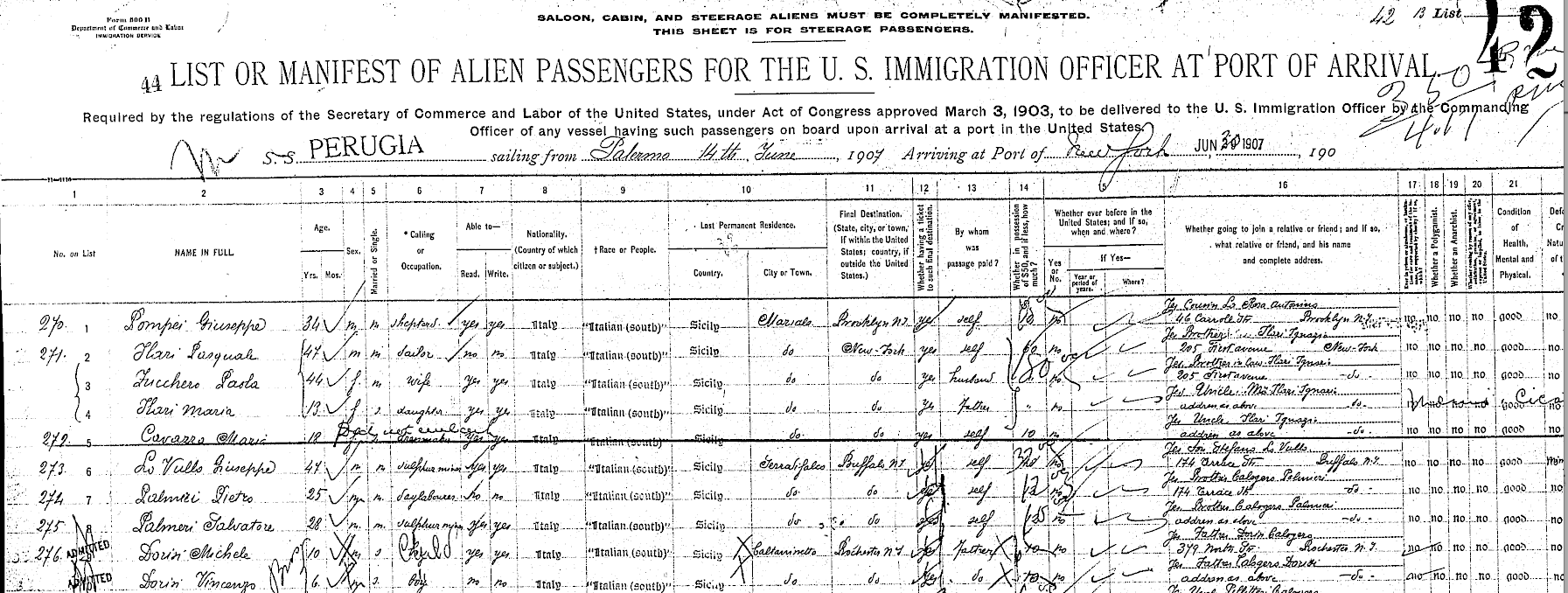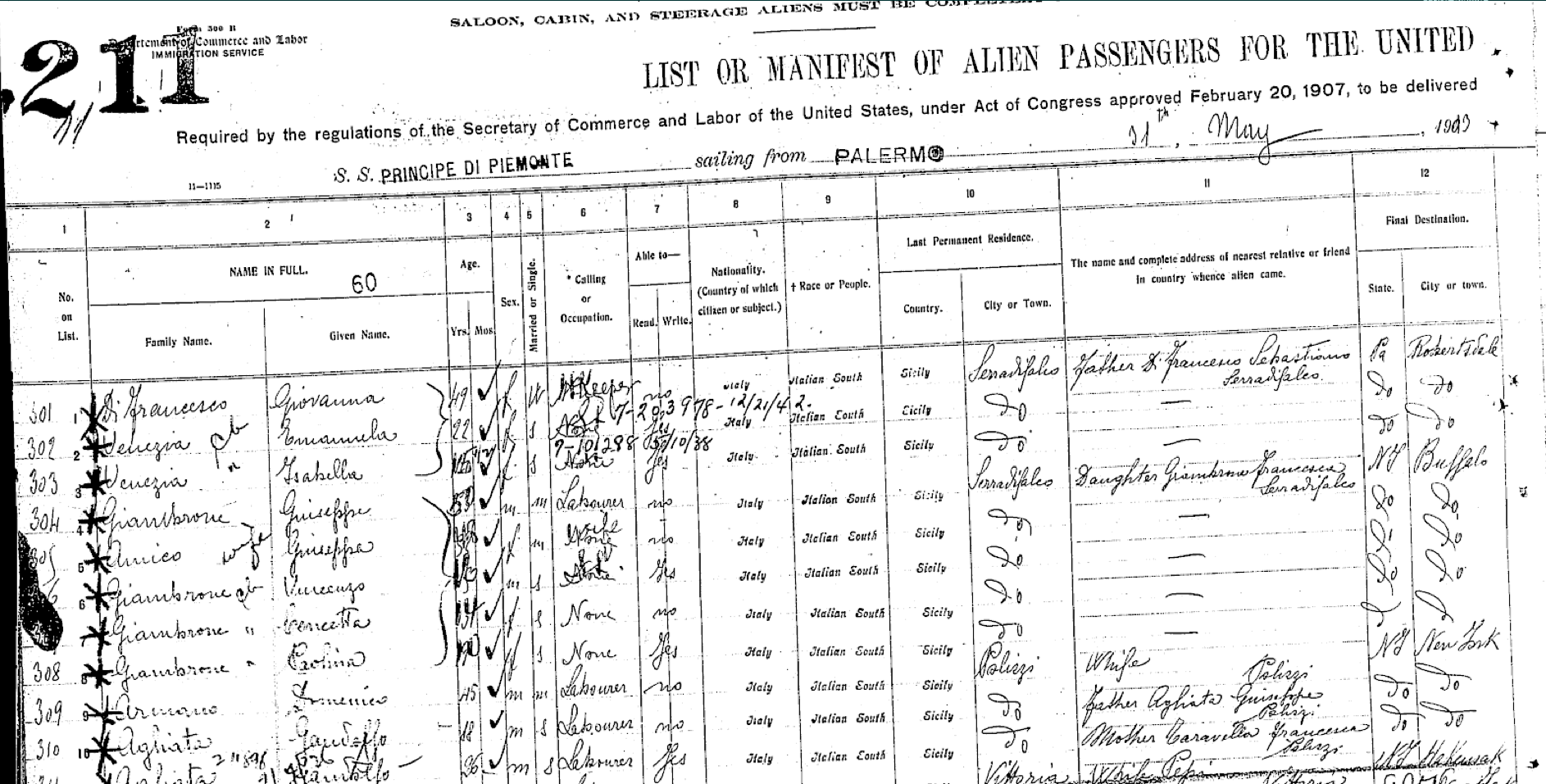From various census records, and because my grandfather was born in the US in 1911, I knew that my great-grandfather came to the US sometime between 1904 and 1910. The 1920 census said 1907 or so, the 1930 census said something like 1904, but it was hard to read. I had no luck at all finding his immigration record on ancestry.com. I was reading a genealogy book and was reminded about ellisisland.org.
I suppose I always figured that it was just the free version of what I was already paying for with my occasional ancestry.com subscriptions. I should have realized that these are independently transcribed and indexed, so it was quite possible to find something on one and not on the other. Sure enough, with a search I found my great-grandfather, Angelo Palmeri.
Angelo Palmeri
arrived on 1 May 1909
departed out of Palermo
traveled on the "Italia" (see below)
"Italia" : Built by D. and W. Henderson and Co Ltd, Glasgow, Scotland, 1903. 4,806 gross tons; 400 (bp) feet long; 49 feet wide. Steam triple expansion engine, single screw. Service speed 14 knots. 1,420 passengers (20 first class, 1,400 third class).One funnel and two masts. Steel hull with two decks. Built for Anchor Line, British flag, in 1903 and named Italia. Mediterranean-New York to 1922 service. Later Glasgow-New York service. Scrapped in 1923.
Interestingly, it lists him as "single" in 1909. That means that he came the US in May 1909, married my great-grandmother Maria Giambrone when she came in June 1910, and my grandfather Joseph Palmeri was born in October 1910.
Angelo was traveling with his sister-in-law, Pietro Palmeri's wife, Giuseppa (Baglio) Palmeri, and his nephew, Pietro's son, Giuseppe Palmeri. The manifest says Angelo was joining his brother Pietro too. Until this past summer, I never knew that my great-grandfather had a brother Pietro, so if I found this before, I would have just rejected it out of hand.
The manifest goes say that they are going to "Yatesboro, PA". Originally I just chalked that up to the immigration officer continuing ditto marks from the people above them. Those listed above him were also from Serradifalco, so he probably assumed they were all going to the same place.
But now I'm a bit uncertain. On the 1920 and 1930 Census, when I found both Pietro and Salvatore and their families, it notes some of their children having been born in Pennsylvania. It could well be that those two brothers spent some time in Pennsylvania (possibly Yatesboro), had some children born there, and later moved to Buffalo.
Serradifalco was a sulfer mining community, and a number of immigrants from there went to work in mines in Pennsylvania. I found some things online that indicated that Yatesboro had coal mines in the early 1900s that were run by the Cowanshannock Coal Company.
So, it looks like my great-grandfather first went to Yatesboro, Pennsylvania, where his brothers Pietro and Salvatore were, possibly working in the coal mines, before heading to Buffalo to join his brother Calogero.

manifest for Angelo Palmeri
My great-grandmother, Maria Giambrone, arrived 24 June 1910. She was going to stay with her sister, Barbara Giambrone, and her brother-in-law, Calogero Palmeri, at 174 Terrace St. in Buffalo.

manifest for Maria Giambrone
Also on ellisisland.org, I found that brothers Pietro and Salvatore Palmeri arrived 30 June 1907. They were going to join brother Calogero who was living at 174 Terrace St. in Buffalo. The manifest also lists father Giuseppe in Serradifalco. They arrive on the "Perugia". It may well be that after joining their brother they went to work in the coal mines for several years in Yateboro, Pennsylvania.
"Perugia" : Built by D. and W. Henderson and Co Ltd, Glasgow, Scotland, 1901. 4,438 gross tons; 375 (bp) feet long; 47 feet wide. Steam triple expansion engine, single screw. Service speed 13 knots. 1,170 passengers (20 first class, 1,150 third class).One funnel and two masts. Steel hull with two decks. Built for Anchor Line, British flag, in 1901 and named Perugia. Mediterranean-New York service. Torpedoed and sunk by a German submarine off Italy on 3 December 1916.

manifest for Pietro and Salvatore Palmeri
I also found Maria's father, my great-great-grandfather, Giuseppe Giambrone, and her mother, my great-great-grandmother, Giuseppa Amico Giambrone. They arrived Jun 13, 1913, out of Palermo, on the "Principe di Piemonte". They were going to daughter Grazia (Grace) Giambrone at 68 Efner St., Buffalo, NY. He was listed as a laborer. They were also traveling with two of their daughters, Concetta and Paulina, and their son, Vincenzo.
"Principe di Piemonte" : Built by Sir James Laing & Sons Limited, Sunderland, England, 1889. 6,560 gross tons; 430 (bp) feet long; 52 feet wide. Steam triple expansion engines, twin screw. Service speed 14 knots. 1,960 passengers (60 second class, 1,900 third class).Two funnels and two masts. Built for Lloyd Sabaudo, Italian flag, in 1889 and named Principe di Piemonte. Italy-New York service. Sold to Uranium Steamship Company, in 1914 and renamed Principello. Rotterdam-New York service. Sold to Cunard Line, British flag, in 1916 and renamed Folia. Only one trip Avonmouth to New York service. Torpedoed and sunk by a German submarine off the Irish coast. on February 11, 1917.

manifest for Giuseppe, Giuseppa, Vincenzo, Concetta, and Paulina Giambrone





